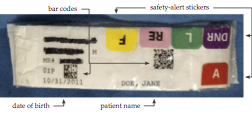Every hospital patient at Gillette wears an identification wristband (ID band). The ID band helps keep you safe while you’re at Gillette.
Your ID band displays your name, your birth date and two bar codes. In addition, Gillette staff might apply color-coded safety-alert stickers to the band.
You and your family are important members of your health care team. It’s important that you understand:
- How your ID band gives us valuable information
- How to make sure your ID band is effective
How do we use the ID bands?
We check your name and birth date before every procedure or test, and we scan a bar code before we give you medicine or draw a laboratory sample. This helps us be sure you get the right care at the right time — every time.
When do you wear the ID bands?
Wear the ID band at ALL times — even if you have a therapeutic pass or we discharge you to another facility. You may remove your ID band ONLY if you’re discharged to your home. And even then: Don’t remove the band until after arriving at your destination.
Only the registrar, a nurse, or a licensed professional health care provider may apply or remove your ID band or safety-alert stickers. We might remove the band for a bath, treatment or procedure and put it back on afterward. If you receive pool therapy, you’ll get a second wristband bearing your name and birth date. You’ll wear this temporary band only during pool therapy.
What do the safety-alert stickers tell us?
If you have risk factors or special medical orders we need to know about, one of your health care providers might apply a safety-alert sticker to your ID band. (If you have more than one type of risk to highlight, we can apply more than one sticker.) The safety-alert stickers tell your health care team how to keep you safe while they care for you.

The safety-alert stickers come in several colors. The table below explains the type of risk each color indicates.
| Red: | Allergy: For patients with any kind of food, drug or environmental allergy or sensitivity — except for latex allergy, which is assigned its own safety-alert color (green). |
| Yellow | Falls: For patients at risk for falling down, which can cause injuries. |
| Purple | Do not resuscitate (DNR): For patients who’ve specifically directed health care providers not to attempt resuscitation if breathing or heart activity stops. |
| Pink | Restricted Extremity: For patients restricted from using or moving one of their arms or legs. (In addition to the sticker on the ID wristband, we place a separate pink band on the arm or leg being protected or restricted.) |
| Green | Latex Allergy: For patients allergic to latex. |
After receiving an ID band, what do I need to do?
Tell a Gillette staff member IMMEDIATELY if:
- There is any incorrect information on your ID band
- Your ID band is removed and not reapplied
- Your ID band is missing
- A safety-alert sticker is missing
- Your nurse applies a new safety-alert sticker and doesn’t explain why
Questions?
Talk to your Gillette nurse.
This information is for educational purposes only. It is not intended to replace the advice of your health care providers. If you have any questions, talk with your doctor or others on your health care team.
If you are a Gillette patient with urgent questions or concerns, please contact Telehealth Nursing at 651-229-3890.
 Home Page
Home Page
